Betty Boop: The Essential Collection: Volume 4 Blu-ray Movie
HomeBetty Boop: The Essential Collection: Volume 4 Blu-ray Movie 
Olive Films | 1932-1937 | 81 min | Not rated | Sep 30, 2014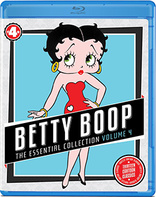
Movie rating
8.1 | / 10 |
Blu-ray rating
| Users | 0.0 | |
| Reviewer | 3.5 | |
| Overall | 3.5 |
Overview
Betty Boop: The Essential Collection: Volume 4 (1932-1937)
Starring: Mae Questel, Cab CallowayDirector: Dave Fleischer
| Animation | Uncertain |
| Short | Uncertain |
| Musical | Uncertain |
Specifications
Video
Video codec: MPEG-4 AVC
Video resolution: 1080p
Aspect ratio: 1.37:1
Original aspect ratio: 1.37:1
Audio
English: DTS-HD Master Audio Mono
Subtitles
None
Discs
25GB Blu-ray Disc
Single disc (1 BD)
Playback
Region A (locked)
Review
Rating summary
| Movie | 4.0 | |
| Video | 4.0 | |
| Audio | 3.0 | |
| Extras | 0.0 | |
| Overall | 3.5 |
Betty Boop: The Essential Collection: Volume 4 Blu-ray Movie Review
Betty, a redhead?
Reviewed by Jeffrey Kauffman September 29, 2014If as the old adage contends, “Everything old is new again,” look no further than Jazz Age icon Betty Boop for a potent example. Just a little
over a month ago it was widely reported in show business trade papers that none other than one Simon Cowell is preparing a new feature
film starring the spunky flapper. Though the project seems to have withered somewhat, a Broadway musical featuring Betty was announced
a few years ago with composer-lyricist Jason Robert Brown attached. So it seems clear that Betty’s allure continues undiminished despite
the intervention of several decades and decidedly different morés since her perhaps less than august debut in 1930. Olive Films has been
releasing some of Betty’s original Fleischer Studio shorts over the past couple of years, offering 4K scans of the cartoons’ original camera
negatives and giving fans their best view of Betty’s scandalous garter in generations. This fourth volume continues that trend, with thirteen
more adventures, including one in Cinecolor.
Reviews of the previous three volumes of Betty Boop can be found here:
Betty Boop: The
Essential Collection - Volume One Blu-ray review
Betty Boop: The
Essential Collection - Volume Two Blu-ray review
Betty Boop: The
Essential Collection - Volume Three Blu-ray review
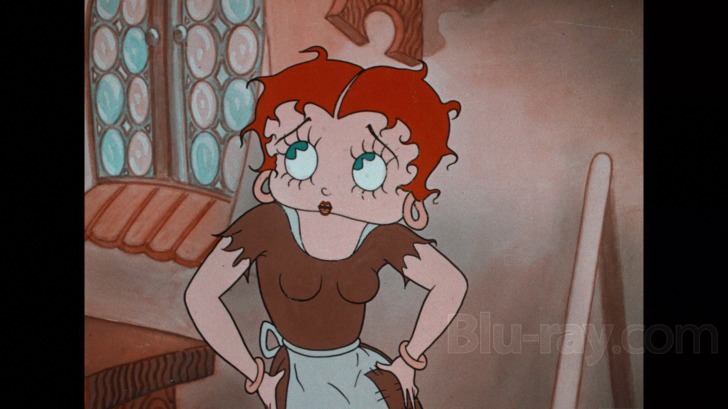
This fourth volume of Betty Boop cartoons contains the following shorts:
Stopping the Show (1932). This was the first officially labeled "Betty Boop Cartoon," one that engendered a surprising legal backlash when chanteuse Helen Kane objected to not just Boop's similar appearance but (perhaps more to the point) the fact that Betty performs a stage act impersonating various stars, including Kane. The Kane segment was evidently excised from many prints for years, but is extant here, along with cute impersonations of long ago superstars like Fanny Brice.
Snow White (1933). The rivalry between the Fleischers and upstart Walt Disney was still in its nascent phases in 1933, but it's interesting that the Fleischers got to this fairy tale years before Walt put his stamp on it and established full length animate fare as a cinematic force to be reckoned with. Betty's version of the timeless story isn't quite the Snow White many will recall, but it's an incredibly imaginative short, including some fun voice work by Cab Calloway. Interestingly, this short still displays the Paramount logo, rather than UM&M.
Parade of the Wooden Soldiers (1934). So, you were one of that crowd who applauded Toy Story for its innovative plot involving toys that are really "alive"? Guess what? Betty got there first, in this small scale but appealing piece dealing with a gaggle of toys and one very mischievous King Kong action figure. This is another Boop short with a brief live action musical prelude, in this case violinist Rubinoff, who also appeared in 1933's Morning, Noon and Night, found in Betty Boop: The Essential Collection - Volume Two.
She Wronged Him Right (1934) offers a throwback to vaudeville entertainments of yore, when supposedly helpless females dealt with dastardly landlords who were demanding payment of the carnal kind if the rent couldn’t be mustered. There’s a certain “meta” quality to this short, with the implication that the entire scenario is a stage production. Betty's sometime paramour Fearless Fred makes his debut in this short.
Red Hot Mamma (1934). Many of the Fleischer outings with Betty had an almost surreal quality to them, and that aspect is on display here, with Betty attempting to stay warm on a frosty winter night, and instead dreaming that she’s entered one place that is incredibly warm—namely, Hell itself. Even Satan can’t withstand Betty’s charms, but in a demonstration of “if looks could kill” (or at least freeze), Betty manages to keep things under control, if only barely.
Poor Cinderella (1934) is the set’s sole color offering (and in fact the only time Betty appeared in color during the Fleischer years), in the now largely forgotten Cinecolor process. Two-strip Cinecolor didn’t feature the lustrous deep reds and blues of Technicolor, tending to have a kind of ruddy pink ambience a lot of the time, but it’s fun to see Betty in something other than black and white, even if her red hair comes as something of a surprise. This has some effective rotoscoped animation (the Fleischers of course would take rotoscoping to a whole new level a few years later with their Gulliver's Travels).
There’s Something About a Soldier (1934). Decades before DDT, Betty enlists the aid of America’s would be fighters to help rid the world of the menace of—mosquitoes. This odd little entry features another appearance of Fearless Fred, who has a somewhat ungainly BMI until he’s whipped into shape to help defeat the itchy enemy.
When My Ship Comes In (1934). This piece of wish fulfillment probably generated a lot of dreaming in its Depression Era audiences, for it depicts the result of Betty winning a rather handy sum in the lottery and then bestowing her largesse on society as a whole. The Fleischers’ ingenuity in creating all sorts of Rube Goldberg contraptions to aid “modern” life is once again on display in this cute and surprisingly effective short.
Zula Hula (1937). Betty often skirted subjects or depictions that would be considered politically incorrect by today’s standards, and that’s the case with this potentially offensive entry that sees Betty and Gramps crash landing on an island inhabited by a bunch of nasty cannibals. Racial stereotypes notwithstanding, once again the Fleischers come up with a variety of gadgets and gizmos that help the pair survive in the wilderness.
Riding the Rails (1938). What would a Betty Boop collection be without at least one short offering Betty’s mischievous dog Pudgy a featured role? Volume Four actually offers a trio of Pudgy adventures, with this being the first. Pudgy wants to hang out with Betty (of course), and has a series of misadventures on the subway, ultimately learning that timeless lesson that there’s no place like home.
The Swing School (1938). The ever industrious Betty has opened a music school for pets, and Pudgy is one problematic student. This is a cute entry that features some good music and some funny sight gags.
Pudgy the Watchman (1938). Pudgy’s back, none too happy that he’s supposed to be engaging in feline behavior by helping Betty to rid her house of a mouse infestation. Pudgy’s scrappy demeanor is well on display here, especially when a cat does get involved.
Sally Swing (1938). Betty had been around for close to a decade by the time Sally Swing was released, and the Fleischers perhaps felt the character was in need of a bit of “plastic surgery” to refresh her appearance. This Betty is noticeably more svelte and realistic looking (relatively speaking, of course). Betty’s back in the music business here, trying to get a swing band together for a dance. Rose Marie voices the titular Sally Swing.
Betty Boop: The Essential Collection: Volume 4 Blu-ray Movie, Video Quality 
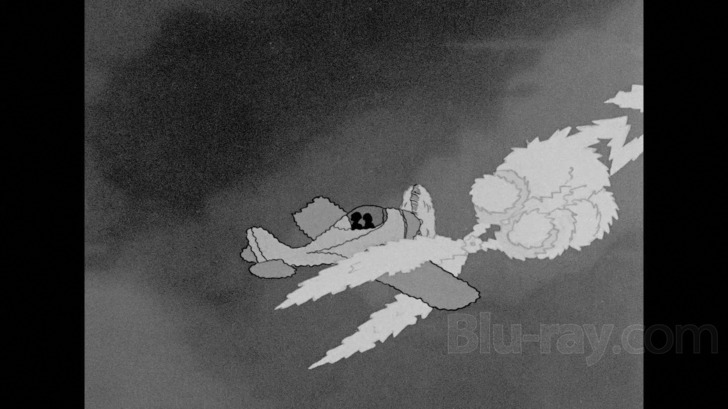
Betty Boop: The Essential Collection Volume Four is presented on Blu-ray courtesy of Olive Films with an AVC encoded 1080p transfer in 1.37:1. This latest volume follows very much in the august footsteps of the previous three, with many if not all of the niggling issues on display here related to the condition of the source elements. There's still quite a bit of scratches, dirt and even emulsion degradation at times, giving the overall quality range here a rather wide berth, but those anomalies are more than offset by the beautifully precise line detail and the nicely filmic thickness and depth to much of the imagery. The lone Cinecolor entry has the weird pinkish hue that's so redolent of this long forgotten process, meaning that reddish hues tend to pop the best. The black and white features are somewhat variable in terms of contrast and depth of black levels, but generally speaking look very good to excellent. Ironically some of the worst looking snippets here are the little live action interstitials like the prelude featuring Rubinoff. As is Olive's wont, there are no signs of digital tweaking throughout these transfers.
Betty Boop: The Essential Collection: Volume 4 Blu-ray Movie, Audio Quality 
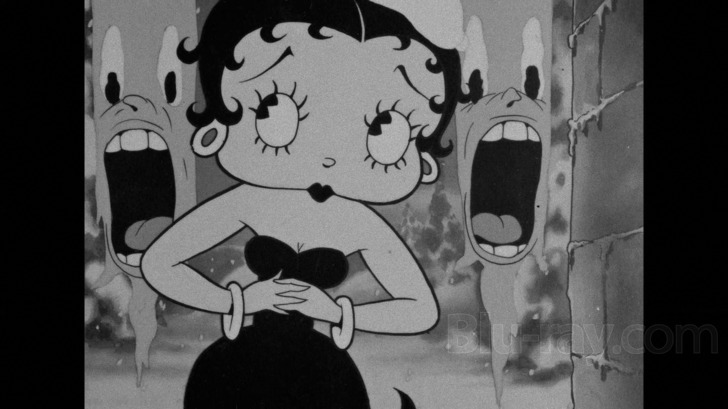
As with previous volumes in this series, given reasonable expectations no fan should be too horribly disappointed in the lossless DTS-HD Master Audio Mono tracks available on this release. Yes, they're boxy, narrow and in quieter moments display easily discernable hiss, but there are no horrible issues with dropouts or actual problematic damage here. Dialogue probably fares a bit better than music, which can sound tinny and unconvincing at times.
Betty Boop: The Essential Collection: Volume 4 Blu-ray Movie, Special Features and Extras 

No supplements are offered on this Blu-ray disc.
Betty Boop: The Essential Collection: Volume 4 Blu-ray Movie, Overall Score and Recommendation 
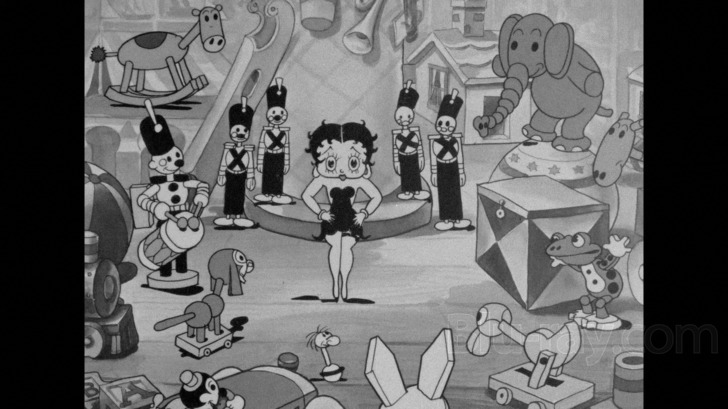
As with previous volumes, and Volume Three in particular, this assortment of shorts is a bit of a grab bag, with some very enjoyable cartoons residing next to some that don't quite have the same panache. Still, it's a gas to see Betty in color (albeit Cinecolor), and several of these outings are highly enjoyable, offering abundant evidence of how innovative the Fleischers could be with one of their most iconic characters. Technical merits continue to be strong here, especially with regard to video quality, and Betty Boop: The Essential Collection Volume Four comes Highly recommended.
Other editions
Betty Boop: Other Editions

The Other Betty Boop Cartoons, Volume 2
1932-1937

The Other Betty Boop Cartoons, Volume 1
1932-1937

Betty Boop: The Essential Collection: Volume 3
1932-1937

Betty Boop: The Essential Collection: Volume 2
1932-1937

Betty Boop: The Essential Collection: Volume 1
1932-1937
Similar titles
Similar titles you might also like

Private Snafu Golden Classics
1943-1946

Popeye the Sailor: The 1940s, Volume 1
Paramount Technicolor cartoons
1942-1957

Tijuana Toads
The DePatie-Freleng Collection
1969-1972

The Blue Racer
The DePatie-Freleng Collection
1972-1974

Ub Iwerks' Willie Whopper
1933-1934

The Dogfather
The DePatie-Freleng Collection
1974-1976

Technicolor Dreams and Black & White Nightmares
1917-1947

Sheriff Hoot Kloot
The DePatie-Freleng Collection
1973-1974

Crazylegs Crane
The DePatie-Freleng Collection
1978

The Witch's Cat
1929

Animation Express
2005-2009

Tex Avery Screwball Classics: Volume 3
Warner Archive Collection
1942-1957

Misterjaw
The DePatie-Freleng Collection
1976

Skulls and Sculls
1930

Monster High: Boo York, Boo York
2015

Mickey & Friends: 10 Classic Shorts - Volume 2
Disney100
1935-1952

Dr. Seuss' Green Eggs & Ham and Other Stories
Dr. Seuss on the Loose: The Sneetches / The Zax / Green Eggs and Ham | Deluxe Edition
1973

Animusic HD
Stunning Computer - Animated Music
2010

Just Spooks
1925

Sure-Locked Homes
1928